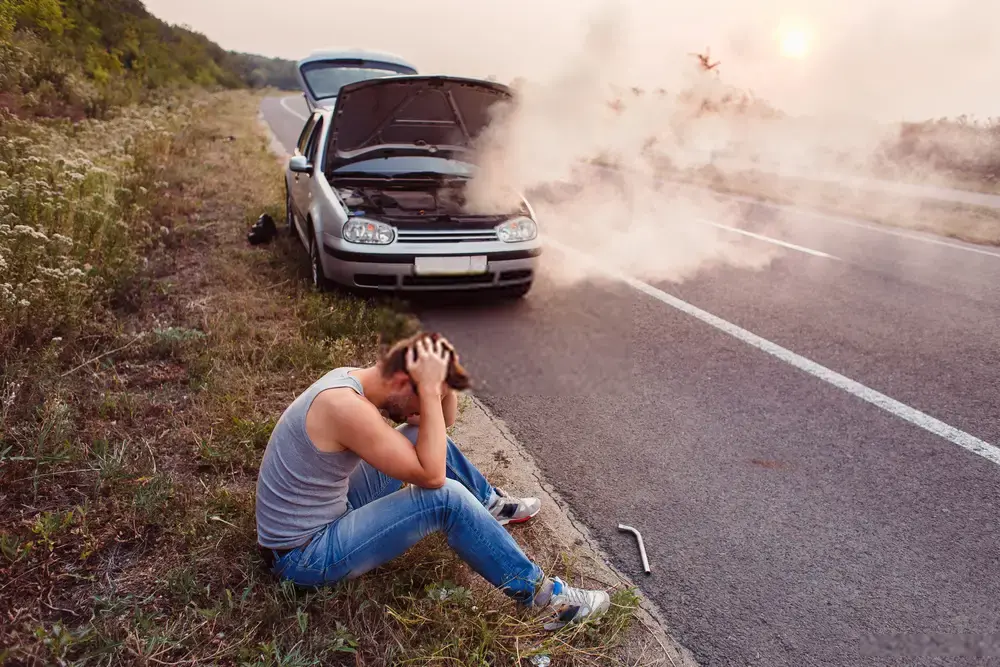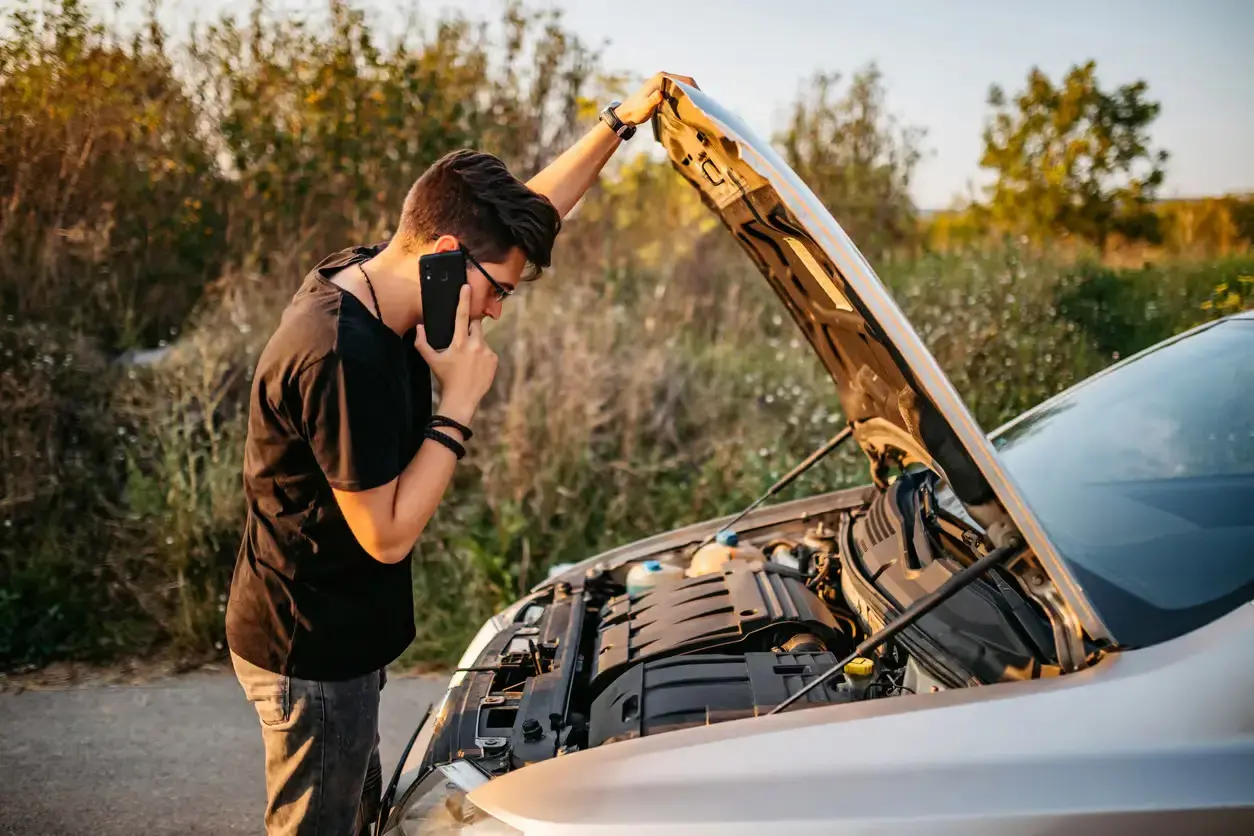 But don’t panic. This comprehensive guide will help you navigate the situation with practical advice on what to do if your car breaks down, including safety tips, essential tools to carry, and how to get the help you need.
But don’t panic. This comprehensive guide will help you navigate the situation with practical advice on what to do if your car breaks down, including safety tips, essential tools to carry, and how to get the help you need.
Staying Safe When Your Car Breaks Down
The most critical aspect of dealing with a car breakdown is ensuring your safety and the safety of your passengers. Here’s what to do immediately.
Pull Over Safely
When you sense something's off with your vehicle, prioritize finding a safe spot to stop. Aim to get completely off the road, like pulling into a shoulder, rest area, or car park. On highways, steer towards the left shoulder for added safety.
Let other drivers know about your situation by using your turn signals or hazard lights. This simple action goes a long way in preventing accidents by signaling that you're in distress.
Make Your Vehicle Visible

Activate your hazard lights immediately. This step is vital as it signals to other drivers that your vehicle is stationary and could pose a hazard.
If you have reflective triangles or flares on hand, strategically position them behind your car. This enhances visibility, particularly during nighttime or inclement weather conditions. Remember to space them out approximately 50 feet apart for maximum effectiveness.
Stay Inside the Car
In most situations, staying inside the vehicle is safer, especially if you are on a busy highway or in a poorly lit area. Keep your seatbelt on and lock the doors.
If you must exit the vehicle (for instance, if you smell smoke or see flames), do so carefully and move to a safe location away from traffic.
Call for Help
Grab your mobile phone and reach out for assistance. Whether it's roadside assistance, a towing service, or a friend who can lend a hand, making that call is crucial. If you're without a mobile phone, keep an eye out for the nearest emergency phone, especially if you're stranded on a major highway.
In situations where you feel threatened or the circumstances seem perilous, like being stuck in a blind corner or in heavy traffic, don't hesitate to dial emergency services immediately. Your safety is the top priority, so trust your instincts and reach out for help when needed.
Essential Tools to Carry
 Being prepared can make a breakdown less stressful. Here’s a list of essential tools and items you should always have in your vehicle.
Being prepared can make a breakdown less stressful. Here’s a list of essential tools and items you should always have in your vehicle.
Basic Toolkit
A set of screwdrivers (both flathead and Phillips) and wrenches of various sizes can help with minor repairs.
Pliers are Useful for gripping and turning parts that may be loose or need adjustment.
Socket Set For dealing with nuts and bolts of various sizes.
Spare Tire and Jack
Spare Tire: Ensure it’s properly inflated and in good condition.
Jack and Lug Wrench: Necessary for changing a flat tire. Familiarize yourself with how to use them.
Jumper Cables
Battery Issues: Jumper cables are essential if your battery dies and you need a jump start from another vehicle.
First Aid Kit
Medical Supplies: Bandages, antiseptic wipes, adhesive tape, and other basic medical supplies for treating minor injuries.
Emergency Supplies
Reflective Triangles and Flares: As mentioned, these are crucial for making your vehicle visible to other drivers.
Flashlight: A battery-powered flashlight (with extra batteries) can be invaluable if you break down at night.
Multi-tool: A versatile tool that can come in handy for a variety of tasks.
Duct Tape: For temporary fixes to hoses, cables, or other components.
Other Useful Items
Blanket: For warmth if you’re stranded in cold weather.
Water and Snacks: Non-perishable snacks and bottled water in case you’re stuck for an extended period.
Portable Phone Charger: To ensure your phone remains charged so you can call for help.
Steps to Take When Your Car Breaks Down
Now that you’re safe and have your tools ready, follow these steps to address the issue.
Diagnose the Problem
 Check for Obvious Issues: Look for any visible signs of trouble such as a flat tire, leaking fluids, or smoke.
Check for Obvious Issues: Look for any visible signs of trouble such as a flat tire, leaking fluids, or smoke.
Consult Your Manual: Your car’s owner's manual can provide clues and troubleshooting steps based on the symptoms you're experiencing.
Warning Lights: Pay attention to any dashboard warning lights. They can give you an indication of the problem, such as overheating, battery issues, or oil pressure.
Perform Basic Troubleshooting
Flat Tire: If you have a flat, use your spare tire, jack, and lug wrench to replace it. Make sure the vehicle is on a flat, stable surface before you start.
Dead Battery: If your battery is dead, use jumper cables to jump-start your car. Ensure you know the proper procedure to avoid damage or injury.
Overheating: If your car is overheating, turn off the engine and wait for it to cool down before checking the coolant level. Never open the radiator cap when the engine is hot.
Call for Professional Help
Roadside Assistance: If you have a roadside assistance plan, call them for help. They can provide services like towing, tire changes, and jump starts.
Tow Truck: If you don’t have roadside assistance, you may need to call a tow truck to take your vehicle to a repair shop.
Mechanic: If you can’t diagnose or fix the problem on your own, a professional mechanic can provide the necessary repairs.
Communicate Your Location
Be Specific: When calling for help, provide clear and precise information about your location. Landmarks, mile markers, and GPS coordinates can be helpful.
Stay Informed: Keep your phone handy and stay in contact with whoever is coming to assist you. Update them if your situation changes.
Preventative Measures to Avoid Breakdowns
While breakdowns can happen to anyone, regular maintenance, and preparedness can significantly reduce the likelihood. Here are some preventative measures to keep your car in good condition:
Regular Maintenance
Oil Changes: Follow the manufacturer’s recommended schedule for oil changes to keep your engine running smoothly.
Check Fluids: Regularly check and top off fluids such as coolant, brake fluid, and transmission fluid.
Tire Maintenance: Ensure your tires are properly inflated and have sufficient tread. Rotate them as recommended.
Battery Check: Have your battery tested regularly, especially before long trips or in extreme weather conditions.
Brake Inspections: Regularly inspect your brakes for wear and tear and replace them as needed.
Scheduled Inspections
Professional Inspections: Have your vehicle inspected by a professional mechanic at least once a year. They can identify potential issues before they become serious problems.
DIY Checks: Perform basic checks yourself, such as inspecting belts and hoses, looking for leaks, and checking lights and signals.
Emergency Preparedness
Know Your Vehicle: Familiarize yourself with your car’s manual and understand the basic functions and indicators.
Keep Supplies Stocked: Regularly check and replenish your emergency supplies and tools.
Plan Your Route: For long trips, plan your route and be aware of the locations of service stations and rest areas.
How to Handle Different Types of Breakdowns
Different breakdown scenarios require different responses. Here’s how to handle some common types:
Flat Tire
Pull Over Safely: Get to a safe, flat location.
Use Your Tools: Grab your spare tire, jack, and lug wrench. Loosen the lug nuts, jack up the car, remove the flat tire, and replace it with the spare. Tighten the lug nuts in a star pattern to ensure even pressure.
Check Tire Pressure: Ensure the spare tire is properly inflated.
Overheating Engine
Turn Off the AC: Reduce the strain on the engine by turning off the air conditioning and turning on the heater to help dissipate heat.
Pull Over: Safely pull over and turn off the engine.
Cool Down: Allow the engine to cool for at least 15-20 minutes before checking the coolant level. Never open the radiator cap when the engine is hot.
Check Coolant: If the coolant level is low, add coolant or water to the radiator. If the problem persists, call for professional help.
Dead Battery
Use Jumper Cables: Position another car close enough for the cables to reach both batteries. Connect the jumper cables in the correct order: positive to positive, negative to negative.
Start the Cars: Start the assisting car, then try to start your car. Once your car starts, let it run for a few minutes to charge the battery.
Check Battery Health: Have your battery and charging system checked as soon as possible.
Engine Stalls or Won't Start
Check Fuel Level: Ensure you haven’t run out of fuel.
Listen for Noises: Listen for any unusual sounds when you turn the key. Clicking noises could indicate a battery issue, while no sound might point to a starter problem.
Check Connections: Inspect the battery terminals for corrosion or loose connections.
Call for Help: If the problem isn’t immediately apparent
In conclusion, experiencing a car breakdown can be stressful, but with the right knowledge and preparation, you can handle the situation safely and efficiently. Remember to prioritize your safety by pulling over to a safe location, making your vehicle visible to others, and staying inside the car whenever possible. Utilize essential tools and supplies to address minor issues and call for professional help when needed.
Regular maintenance and preventative measures are key to reducing the risk of breakdowns. By staying on top of maintenance tasks and keeping emergency supplies stocked, you can minimize the chances of encountering problems on the road. Knowing how to handle different types of breakdowns from flat tires to engine issues can help you navigate unexpected situations with confidence.
Ultimately, the key to successfully handling a car breakdown is preparation, awareness, and staying calm under pressure. By following the advice outlined in this guide, you can navigate through any breakdown scenario and get back on the road safely. So, whether you’re embarking on a long road trip or simply commuting to work, take the time to prepare for the unexpected. Your peace of mind and safety are worth the effort. Safe travels!